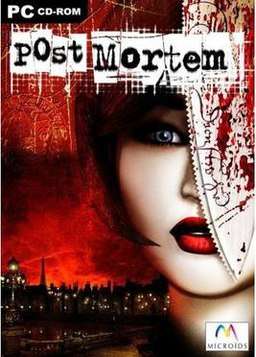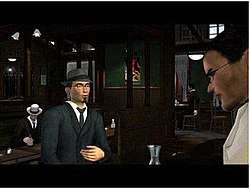Post Mortem (video game)
| Post Mortem | |
|---|---|
 European cover art | |
| Developer(s) | Microïds |
| Publisher(s) |
Microïds (France) The Adventure Company (North America) DreamCatcher Interactive |
| Designer(s) | Stéphane Brochu |
| Engine | Virtools |
| Platform(s) | Windows |
| Release | |
| Genre(s) | Adventure |
| Mode(s) | Single-player |
Post Mortem is a murder mystery adventure game by Microïds, released in 2002. Its sequels are Still Life and Still Life 2. The game was also released in French, Italian, German and Spanish.[1]
Gameplay

Post Mortem uses a first-person player view and a point and click user interface, using only the mouse for control. This slightly differs in its sequel, Still Life, however as it is a third person game.
Different cursors appear over portions of the screen to show the player what will happen when it is clicked on.
Gus' notebook is used to collate both the menu system of the game and the place to view documents obtained within the game.
Characters
- Gustav McPherson - A private detective, who grew up in New York City currently working as an artist in Paris.
- Sophia Blake - Sister of the murdered woman, enlists Gus to investigate the murders
- Ruby and Regis Whyte - Married American couple on vacation in Paris, found murdered at the Hotel Orphee
- Isidore Petit - Receptionist and manager of the Hotel Orpee
- Mrs. Loiseau - Psychic staying at the Hotel Orphee
- Theo Malet - Bellboy at the Hotel Orphee
- Nicolas - Waiter at Nantis Cafe
- Albert Hulot - Owner of the Alambic Bistro
- Berenice (Bebe) - Working girl in Paris around the Alambic Bistro
- Jacques Helloin - Detective, previously worked for Police
- Beauvais - A policeman in Paris
- Inspector LeBrun - Police inspector investigating the Whytes' murders
- Gregoire de Allepin - A banker in Paris
- Dr. Frank Kaufner - Psychiatrist, works with the Police
Development history
Microïds developed and completed Post Mortem in ten months using Virtools Dev. An in-house team of 27 people created the game. This included 8 graphic artists, 5 animators and 6 programmers.[2] To ensure the game had variety and no linear storyline, Microïds used a software called "Natural Dialog Engine".[3] Post Mortem was later followed by a spin-off series, Still Life, which has currently produced two games. On September 19, 2008 a new Still Life series website was opened, covering the three games.
Reception
| Reception | ||||||||||||||||||||
|---|---|---|---|---|---|---|---|---|---|---|---|---|---|---|---|---|---|---|---|---|
| ||||||||||||||||||||
The reception of Post Mortem was mixed, with a range of review scores ranging from 43, from Game Revolution, to a high 87 from PC Game World.
References
- ↑ "Post Mortem - Microïds". Retrieved September 15, 2017.
- ↑ "Virtools Applications used in making Post Mortem". Virtools. Archived from the original on 2008-03-13. Retrieved 2008-09-19.
- ↑ "Microds' Post Mortem Shaping Up!". September 27, 2011. Retrieved September 15, 2017.
- ↑ "Post Mortem for PC - GameRankings". GameRankings. Retrieved September 14, 2017.
- ↑ Evan Dickens (January 27, 2003). "Post Mortem Review". Adventure Gamers. Retrieved September 14, 2017.
- ↑ Cook, Denice (June 2003). "Post Mortem - Computer Gaming World" (227). Computer Gaming World: 90. Retrieved September 14, 2017.
- ↑ Ron Dulin (February 28, 2003). "Post Mortem Review - Gamespot". Gamespot. Retrieved September 14, 2017.
- ↑ Staci Krause (February 25, 2003). "Post Mortem - IGN". IGN. Retrieved September 14, 2017.
- ↑ MacIsaac, Jason (December 8, 2002). "Post Mortem". The Electric Playground. Archived from the original on August 3, 2003.